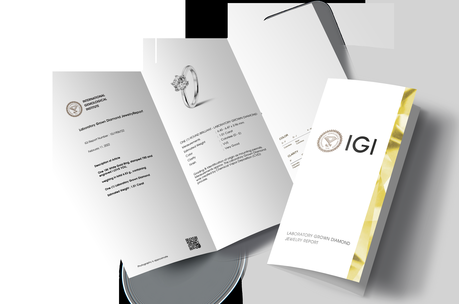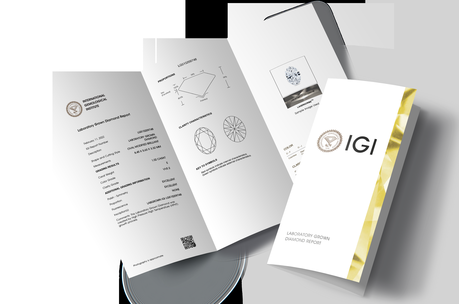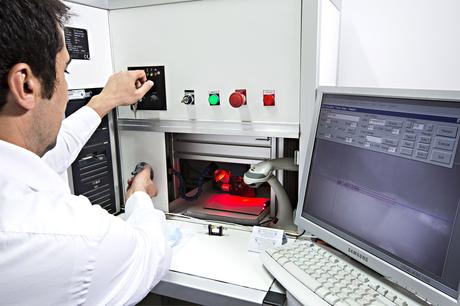International Gemological Institute (IGI) is the world's largest gemological organization. First established in 1975 in Antwerp, the world capital of diamonds, IGI now operates 29 grading laboratories and 18 schools in 10 countries around the world and employs a workforce of over 1,000 dedicated professionals. We recently sat down with IGI's senior director of education, John Pollard to gain some intel on IGI and answer some questions often asked by PriceScopers.
To the new IGI office located at 545 Fifth Avenue in New York City.
1. Who is IGI? and What Does IGI Offer Consumers?
As lab-grown diamonds have grown in popularity IGI has developed affordable screening services for professionals and consumers, to ensure no unintentional mixing of natural and lab-grown diamonds.
2. Not all appraisals are created equally. Can you give us a quick breakdown of the different appraisal offerings at IGI?
IGI provides appraisals for estate tax calculation, financial audits, and insurance coverage. IGI appraisers are accredited by the American Society of Appraisers (ASA) and undergo annual continuing education.
IGI Appraisals are accepted by all major insurance carriers, many of whom now require 3rd party appraisals for high-value pieces.
All appraisal reports include screening services to identify natural and lab-grown diamonds, along with a description of the item's gemstones, metals, and mounting details. All appraisal reports include a QR code, linking to the digital version of the report, with supplemental education.
Appraisal reports are customizable. They range from full-size reports including photos and loose grading information to items graded as mounting permits, to economical 'credit card' formats.
For designers and brands, IGI produces co-branded reports so that all gemological details, the item's insurance valuation, and the maker's identification are all together on the document of authority. IGI has recently begun producing co-branded reports for independent retailers, for the same purpose.
Appraisal Report Purposes
3. How can PriceScopers Benefit from IGI's eLearning Coursework? Which IGI course(s) do you recommend starting with?
IGI eLearning Courses are designed to help jewelry enthusiasts and professionals alike. They stand apart from other courses because they focus on what's important for sellers and buyers to know when trading diamonds.
Each course takes less than 45 minutes to complete. Each course is interactive, with challenge questions along the way. Each course ends with a 12 question quiz (take as often as needed). Upon completion, users receive a summary PDF with all course content and supplemental information.
"IGI's eLearning Courses are ideally suited, and ideally timed, for a global audience of people looking to acquire first first-rate, professional online gemological education"
"The content is incredibly beneficial for both experienced and new professionals alike. As a jeweler of 45 years, I was fascinated with the depth of the information provided"
4. What Sets IGI Apart from its Direct Competitors?
IGI adopts a business-to-consumer philosophy. Most people enter a jewelry store to buy jewelry, not loose gemstones. IGI was the first lab to provide reports for finished jewelry - which are easy to understand while being comprehensive enough for jewelry professionals - as well as loose diamond and gemstone grading reports.
Jewelry grading is more complex than loose stone grading. IGI has developed methods to decisively assess mounted gemstones, yet we treat those grades conservatively. When the comment "graded as mounting permits" appears, color and clarity are stated as a range such as D-E or SI1-SI2, etc. When the gemstone was graded prior to mounting that's noted on the report and standard 4Cs reporting applies.
IGI holds a seat on the World Diamond Council, is the first gemological institute to hold ISO laboratory accreditation for both natural and lab grown diamonds, and is the first to commit to carbon neutrality.
IGI pioneered the grading of lab-grown diamonds in 2005, giving the industry its first benchmarks in disclosure and authenticity, and has more experience and expertise in that sector than any other institute.
IGI proactively partners with almost all luxury brands around the world, screening millions of carats of their melee to ensure integrity and providing ongoing education for their sales professionals.
IGI was the first to include rough and lab-grown diamond education in schools of gemology and now instructs more diverse courses in more locations and more languages than any other gemological organization.
IGI is more fully engaged with end-consumers around the world since finished jewelry is purchased at a far higher frequency than loose gemstones.
5. Some diamond advice sites suggest that IGI color and clarity grading standards are not as strict as those used at GIA. True or false?
False. I can provide some personal perspective regarding that.
Before working for IGI, I trained retail jewelers all around the USA. During those years I read and heard 'softer grading' assertions from colleagues when any lab other than GIA was discussed. None of those colleagues were using or seeing IGI reports, it was just said and repeated without checking.
Fast forward to 2023, and I'm regularly hearing different, positive comments from the very same colleagues. It's because lab-grown diamond popularity is bringing IGI reports into their stores. They have begun using IGI reports personally and are realizing those old, unchecked assumptions were wrong.
It was interesting that one comment from a respected panelist gave the entire room 'permission' to share how pleased they are with IGI in opposition to old rumors - rumors largely attributable to a completely different European lab, which was eventually banished from prominent diamond trading platforms, including PriceScope, for over-grading.
I am GIA trained, working in the trade since 2004. I first discovered the integrity of IGI's processes and standards in the mid-2000s, providing education for IGI Antwerp, Hong Kong, and Shanghai. During the pandemic, I taught courses via Zoom on behalf of IGI North America for quarantined sales professionals from several iconic luxury brands. I accepted a full-time position with the institute on Jan 1, 2022.
Any questions about IGI standards can be answered by using IGI services. The business has tripled over the past several years as more professionals experience the care, consistency, and integrity IGI's experts apply throughout the process of intake, identification, and grading. I believe jewelers around the USA are now getting to know us.
6. Why Should Consumers Get an IGI-Certified Lab Diamond?
For consumers seeking availability, IGI grades the majority of the world's lab-grown diamond output. That typically gives shoppers a wider range of choices. There is also the matter of authority. IGI has been analyzing and grading these stones longer than any other institute, by up to 15 years, making an IGI lab-grown diamond report the industry standard.
7. Does IGI Grade Consumers Pre-Loved Jewelry?

Yes, and with increasing reports of fraud and mixing (purposeful or accidental) involving natural and similar lab-grown diamonds, using IGI's affordable consumer grading and screening services whenever a piece changes hands is becoming critical to protect buyers and sellers alike.
8. Grading Lab diamonds has not come without controversy, where does IGI stand on the Lab vs. Natural debate?
IGI takes a neutral position. There is demand for both. Our purpose is to identify and disclose grading particulars for each gemstone or jewelry item that is sent to our laboratories.
IGI has been grading natural diamonds and colored stones since 1975. We sensed the industry's need for lab-grown diamond grading reports in 2005 and decided to be the first to issue them. We chose to make the report covers yellow to clearly delineate them while analyzing them with the same 4Cs as natural diamonds. We did this to protect the industry and consumers with clear disclosure, paired with the efficiency of using established grading criteria.
9. Can you take a moment to explain Responsibility and Sourcing as educational concepts per IGI? How has that changed in the current era vs. the history of the industry?
One of our eLearning Courses is The Natural Diamond Story. It discusses the history of natural diamond sourcing, matters of both human and environmental stewardship, and the dramatic positive change being enacted by major industry players since the turn of the century.
We publish news involving all of this on our IGI GemBlog. Subscribers receive one email per week, linking to the latest intelligence and insight from IGI worldwide. Subscribe to the IGI GemBlog.
Succinctly put, no other industry has done more to oppose the trade of conflict minerals than the diamond industry. These stories need to be more front and center for consumers.
10. How is IGI Being Sustainable?
The institute's New York offices spearheaded this initiative, first offsetting their carbon footprint in 2022. In 2023 IGI New York additionally expanded to the 11th and 12th floors of 545 Fifth Avenue , one of NYC's first buildings to became a sustainable office building, boasting an environmentally responsible design, showcased by LEED Gold green building certification .
Progress toward carbon neutrality at IGI locations involves actions such as the installation of smart thermostats and LED lighting equipped with auto-off settings and commitment to environmentally safe cleaning products from sustainable companies. Employees are asked to reduce their print frequency, eliminate single use plastics, diminish the amount of trash generated per-person, follow an unplug policy and sort trash into categories, among other improvements. The institute plans to continue proactive environmental stewardship, with a goal of 30% reduction by 2025.
11. Are Lab-Grown Diamonds Sustainable?

No, with rare exceptions. Lab-grown diamonds do not require mining, caving, or dredging, so they are not environmentally invasive. However, the presses, reactors, and plasma chambers used to produce them require enormous energy. Since the vast majority are produced by burning fossil fuels, they cannot be considered sustainable, green, or eco-friendly.
With that said, there are a small number of sustainable lab-grown diamond producers. SCS Global, a leader in sustainability auditing, has developed a sustainability certification for diamond producers.
When a diamond is accompanied by a sustainability certificate IGI will document that status on the lab grown diamond grading report, along with a QR code linking to the sustainability document. For consumers seeking sustainable products these stones are rare but do exist.
In the big picture: When buying or selling, any claims of sustainability should be documented from producer, to supplier to retailer to consumer.
12. What are your 2023 Predictions for Natural and Lab-Grown Diamonds?
During the pandemic people demonstrated that diamonds remain important, in terms of gifting, emotional symbolism and marking life events. We expect to see the popularity of diamonds continue to flourish.
The natural diamond story is one of infinite history. The romance of natural gemstones and their connection with a forever past and future has proven exceptionally strong over time. The 'forever' prospect of natural diamonds is the reason for the diamond engagement tradition and natural diamonds will remain front and center for many jewelers, including the most celebrated luxury brands.
Lab grown diamonds are still newcomers, relatively speaking. Consumers tend to discover they exist when shopping for engagement, anniversary, or other gifting event. There is a growing audience of shoppers for whom lab grown diamonds have appeal, whether as a supplement to a natural diamond, or a substitute for it. Their affordability continues to fuel their popularity.
IGI has always treated natural, and lab grown diamonds as two separate products which can coexist, as long as there is clear differentiation and disclosure, with no inadvertent mixing. Each product stands on its own merits.
13. How has IGI's Laserscribe® Benefitted the Diamond Industry?

IGI co-created the modern inscription process, now common throughout the diamond industry.
Using a very fine and precise laser beam, alphanumeric characters, a brand logo, even a personalized message can be inscribed on the girdle or outside circumference of a diamond. Adding the report number to a diamond's girdle with Laserscribe® permits fast identification under magnification, permitting verification of all of its gemological details.
Now standardized as an efficient and easy way to identify a diamond, the majority of diamonds around the world have laser inscriptions.
Do you have any questions for IGI? We invite you to click the comments button below and engage in the Forum.
